We may earn revenue from the products available on this page and participate in affiliate programs. Learn More ›
Walther has a long-standing reputation for producing quality pistols like the P38 and PPK, and fans of the current Walther PDP lineup claim that there isn’t a better striker-fired pistol made today. The PDP has been around for a few years, evolving from the PPQ and earlier P99, but Walther has been hard at work developing different models in the lineup. One of the newest is a steel-framed, full-size pistol that’s meant to fill both match and duty roles. The PDP platform generally has great ergonomics, controls, and is shooter friendly. This new PDP Steel Frame Match 5-inch model comes optic ready, sports Walther’s Performance Duty Trigger (PDT), and has the recoil-mitigating weight that only a steel frame can provide.
See It
Specs
- Caliber: 9mm
- Capacity: 18+1
- Magazine Material: Steel
- Dimensions: 5.75 inches (H) x 8.37inches (L) x 1.37 inches (W)
- Weight: 43 ounces (weighed with empty magazine, no optic)
- Frame: Steel
- Slide: Steel, black finish
- Barrel: 5-inch, black finish
- Sights: Polymer 3-dot, white, adjustable rear
- Optic ready: Yes, uses Walther adapter plates
- Trigger: PDT (Performance Duty Trigger), Single-action, flat shoe, 4 pounds 10 ounces (measured)
- Safety: Trigger safety bar
- Price: $1,920
Key Features
- Heavy steel frame with wrap-around polymer grip scales
- 5-inch barrel
- PDT Trigger
- Adjustable 3-dot white sights
- Optic cut that uses Walther optic plates
- Aluminum magwell
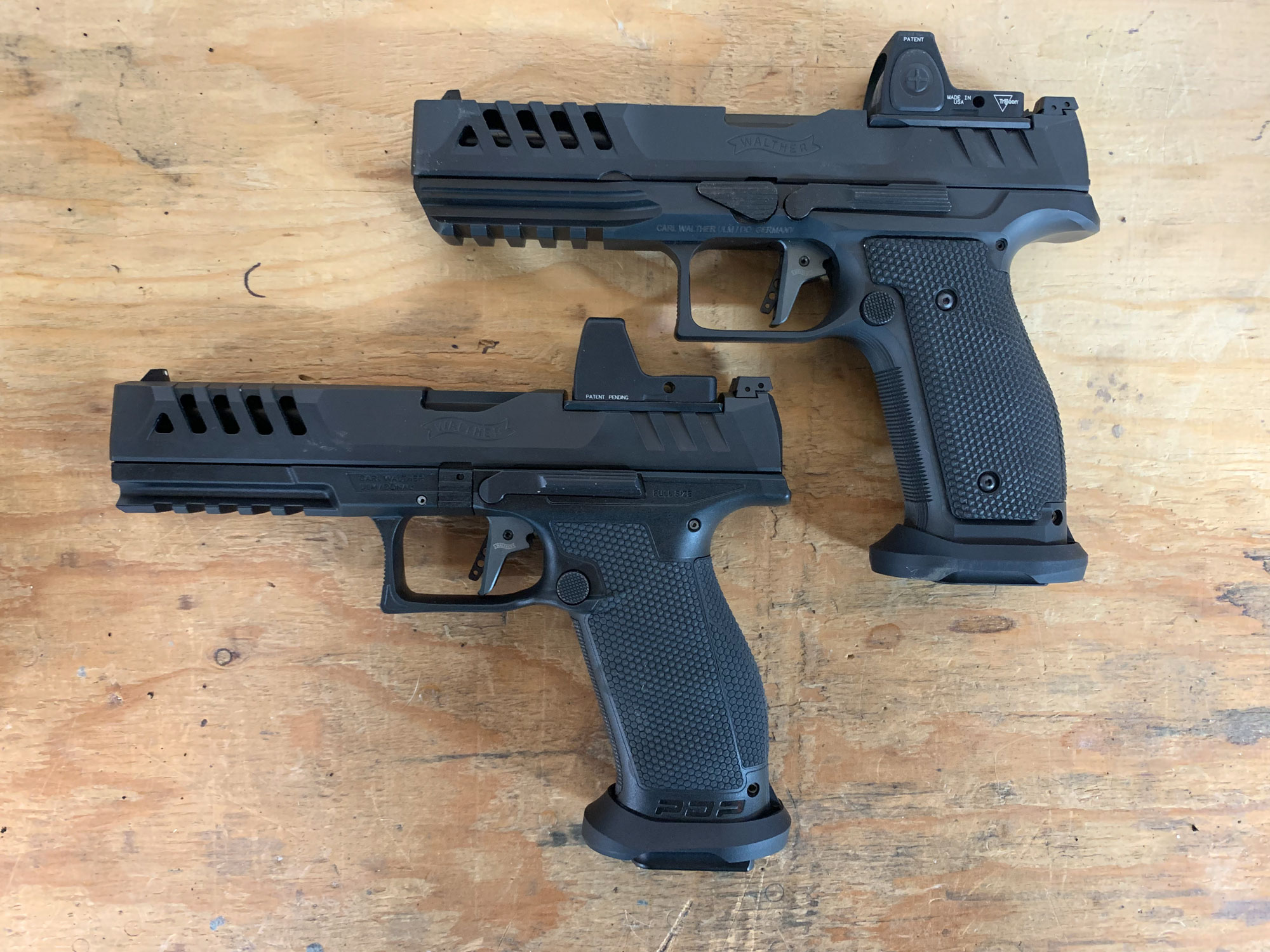
Walther PDP Steel Frame Match Review Highlights
- Steel frame helps mitigate recoil
- Excellent trigger
- Optic-ready, uses adapter plates
- Accurate, reliable, and easy to shoot
- Average Group Size: 1.16 inches ( 19 5-shot groups at 15 yards)
The Walther PDP Steel Frame Match: The Difference of Steel
For many years, the striker-fired pistol and polymer have been in symbiosis. In fact, polymer is a big part of what made striker-fired pistols like Glocks economical in the first place. It is strong, affordable, and polymer pistol frames are easy to mass produce. Polymer is still the dominant material for striker-fired guns. Walther uses it in most of its PDP pistols like the PDP F-series, but steel-framed models have been trickling onto the market from other manufacturers for a few years now. In our various tests and reviews, we’ve seen Sig and Smith & Wesson offer steel-framed versions of their polymer pistols. So, what’s so great about the steel?
Advantages of Steel Frames
Steel frames are much heavier than their polymer counterparts. That might be unappealing to some, but the most obvious way a steel frame can aid the shooter is that weight. Any part of the gun that doesn’t move—technically referred to as non-reciprocating mass—contributes to how much recoil a shooter feels. The greater the non-reciprocating mass, the softer the felt recoil. A pistol with a lighter slide and heavier frame won’t recoil with the same perceivable sharpness that a pistol with a lighter frame will.
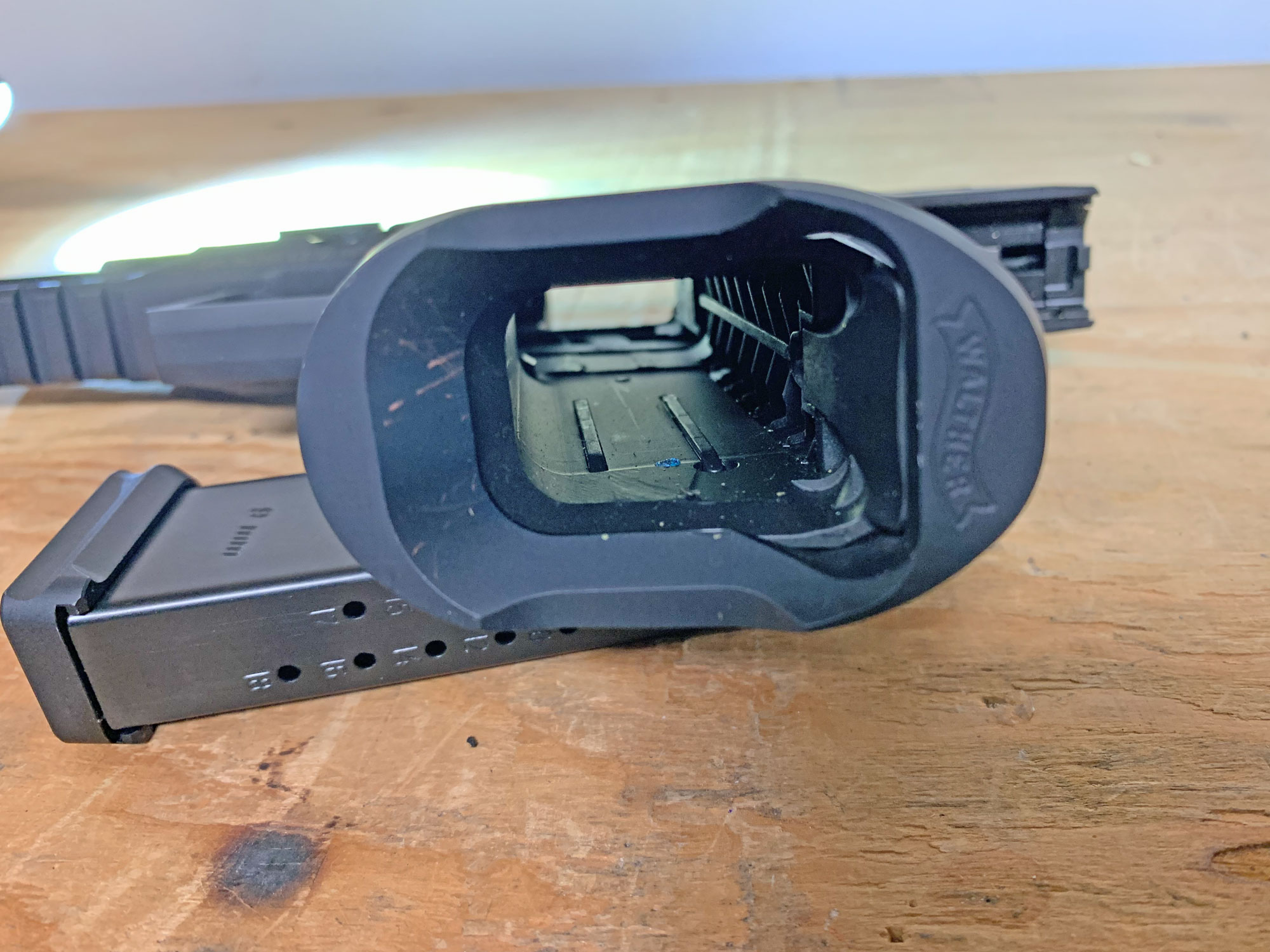
A heavier frame can also help the gun work better. Blowback (recoil) operated semi-automatic pistols use the force of a cartridge’s recoil to drive the slide back against the recoil spring and eject the spent case. If you don’t hold a semi-automatic pistol tightly, the force of the recoil moves the whole gun rather than just the slide. When that happens, you’ll encounter a number of function-related problems. This is commonly known as “limp-wristing.” You still can’t get away with limp-wristing a steel-frame gun, but that added mass does make it more forgiving for the shooter.
I was able to compare the Walther PDP Steel Frame Match pistol directly to the full-sized PDP polymer-framed match pistol and noted that the recoil cycle was both softer and smoother with the steel frame. There wasn’t anything wrong with the polymer-framed gun, but it’s 14.6 ounces — nearly a pound — lighter. With that poly frame, recoil feels quicker and sharper.
How the Walther PDP Steel Frame is Different from the Polymer Frame
Walther’s steel frame and polymer frame are quite similar, and looking at them side-by-side, there are only a few key differences aside from material. First, the polymer frame has an integrally molded grip with slightly more refined hand-fitting contours on the sides. The Walther PDP Steel Frame uses a polymer grip scale that wraps around the back of the frame, and a machined checkered grip texture on the front strap. Aside from their weight, they feel nearly identical in the hand.
The takedown mechanism is different between the two frames as well. The polymer frames use the takedown tabs on either side of the frame that are pulled down to remove the slide from the frame. The steel frame uses a rotating takedown lever.
There are only a couple other notable differences between the two frames. One of them is that the slide rails on the steel frame are longer. The other is a nice bevel on the left and right edge of the steel frame, just above the trigger guard. This small cut makes moving the trigger finger from a resting place on the side of the frame, into the trigger guard, smoother and more efficient. It’s a nice touch.
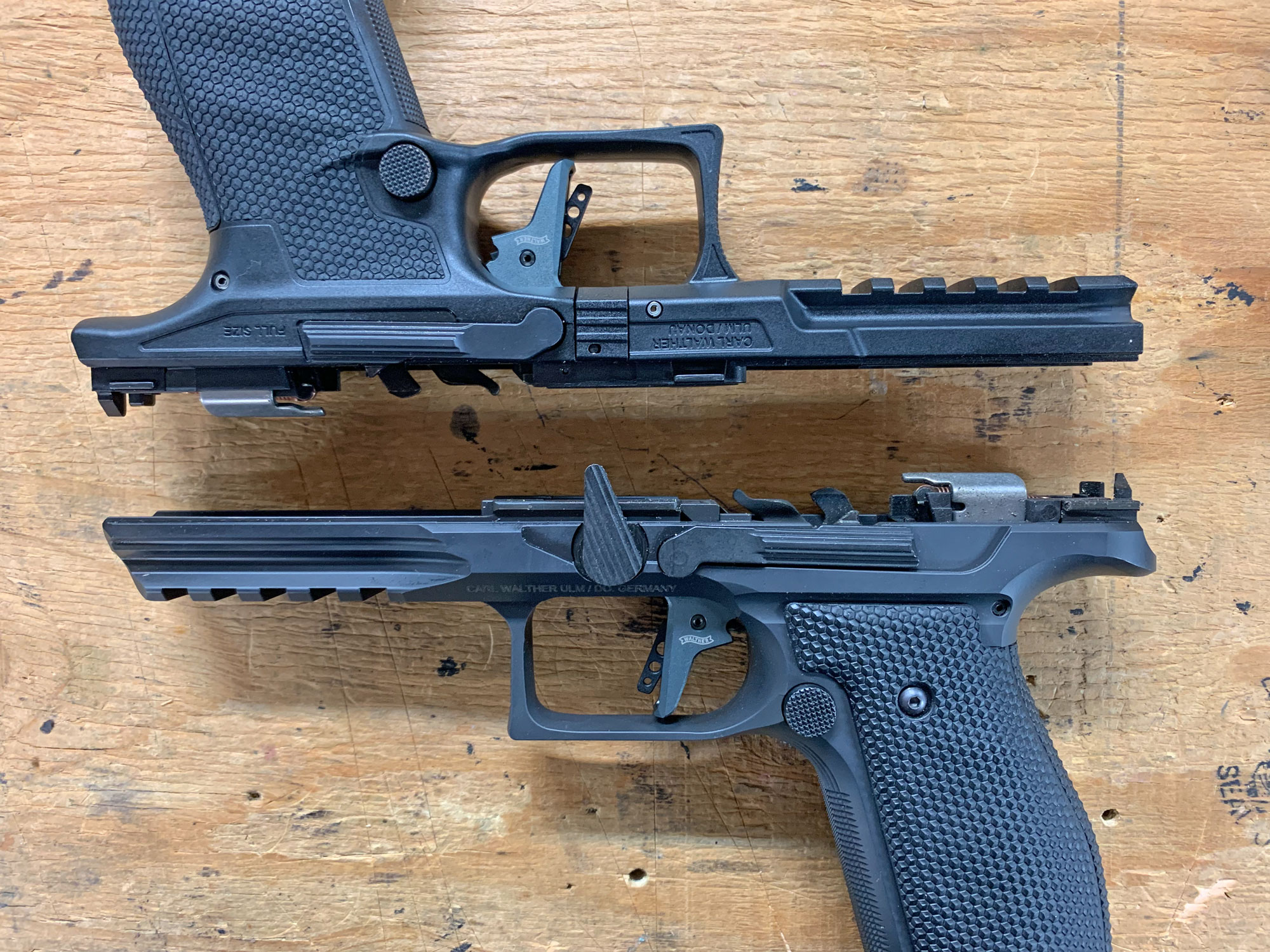
The Walther PDP Steel Frame Match Has a Pristine Trigger
Talking triggers, when it comes to striker-fired pistols, is like talking about that jar of assorted non-chocolate-flavored tootsie rolls that every gas station had when you were a kid. They’re all pretty awful, but some are less awful than others. The Walther PDP Steel Frame Match pistol’s PDT trigger is the vanilla of the bunch. I wouldn’t want it on a precision rifle, but compared to other striker-fired pistols, it’s exceptional. To me, it doesn’t quite help achieve the same level of precise control that a Staccato P, Staccato CS, or other high-end 2011-style pistol trigger gives the shooter, but it’s not far behind.
When I say that striker-fired-pistol triggers are bad, I mean that compared to the trigger system of a well-tuned 1911 or, better yet, a rifle, they require longer pulls, are heavier, and many are gritty or have varying weight throughout the pull. Many striker-fired-pistol triggers also have long resets — the distance the trigger must travel back in a forward direction before resetting and being ready to fire again.
The Walther PDP Steel Frame Match trigger breaks at 4 pounds, 10 ounces according to my Lyman trigger pull gauge. This is light, but not exceptionally so. Many specialized match pistols will have even lighter triggers. Compare this to a stock Glock G19 trigger though. The one in my gun safe breaks at 6 pounds, 12 ounces. That’s not to knock Glock, that is considered standard for a striker-fired pistol..
H3 Apples to Apples: Comparing Striker-Fired Triggers on Steel-Framed Guns
The Walther PDT trigger isn’t just good because it’s light. Frankly, it’s heavier than the triggers on many match pistols. But there’s much more to a good trigger. My Sig P320 AXG Pro with a KGM enhanced trigger, a steel-framed comparative counter to the PDP SF Match, has a lighter trigger pull weight of 3 pounds, 6 ounces. The Walther PDP Steel Frame Match trigger is slightly heavier, but it has a distinct wall, crisp break, and shorter reset than the trigger on the Sig. I spent a lot of time shooting the two pistols side-by-side, and I found myself constantly throwing quick follow-up shots low with my Sig when driving it fast. With the Walther, I could keep the dot from my RMR on target while pouring a steady stream of brass on the ground running Bill Drills.
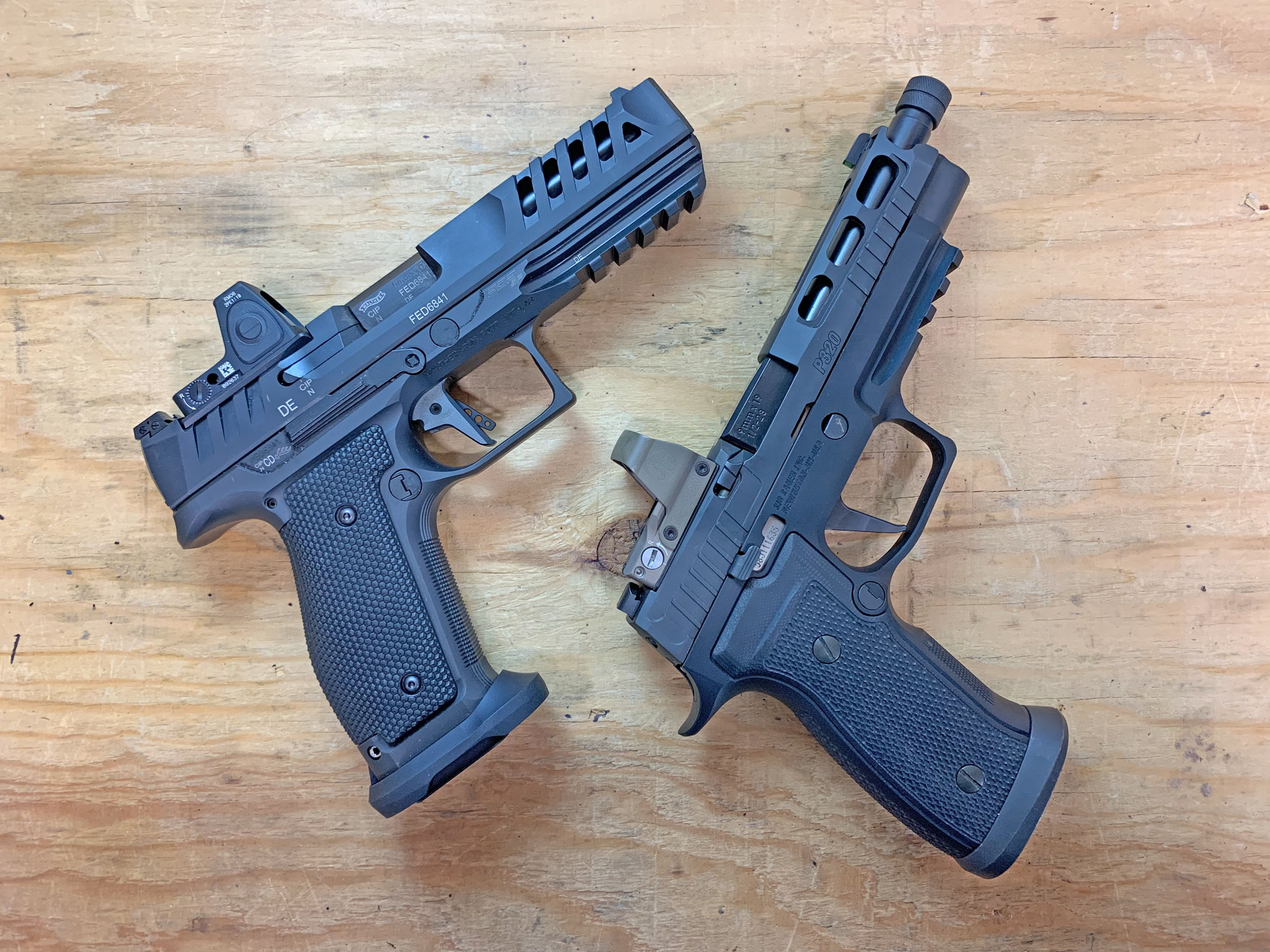
Walther PDP Steel Frame Match: Kit and Kaboodle
The steel frame and trigger are the show-stealers on the Walther PDP Steel Frame Match pistol, but there’s more to it than that. Basically, it’s a gun that’s set up to be competition-ready out of the box. The long slide is styled similarly to other PDP models, with weight-reducing cutouts in the aggressive front slide serrations. The slide comes with Walther’s basic adjustable three-dot iron sights, but features an optic cut that uses Walther optic adapter plates. I topped mine with a Trijicon RMR
The grip is capped with a healthy-sized aluminum magwell that funnels magazines smoothly into the frame during quick reloads. Walther includes three 18-round magazines with the PDP Steel Frame, which are enough to get started for most action pistol shooting matches. Many times, two magazines aren’t enough to get through a match stage. I applaud them for being generous with magazines when so many companies skimp, but I would prefer them to be 20-, 22-, or 23-round mags for a match gun like this. Several companies like Floyd’s Custom Shop do make extended baseplates that can add up to 4 rounds, but I wish they came standard.
I was particularly impressed with how nicely magazines interfaced with the steel frame. Fully-loaded magazines lock into the gun with very little pressure, which is a big plus for a ready-made competition gun. Many pistols require a solid smack on the magazine base plate to ensure it doesn’t fall right back out, but not the PDP Steel frame. Empty magazines spring free of the gun when pressing the large, easy-to-reach magazine catch button. Like some other higher-end guns, the Walther steel frame features ribs on the inside of the frame that contact and guide the magazine. These ribs reduce the surface area that contacts the magazine and thus reduces friction.
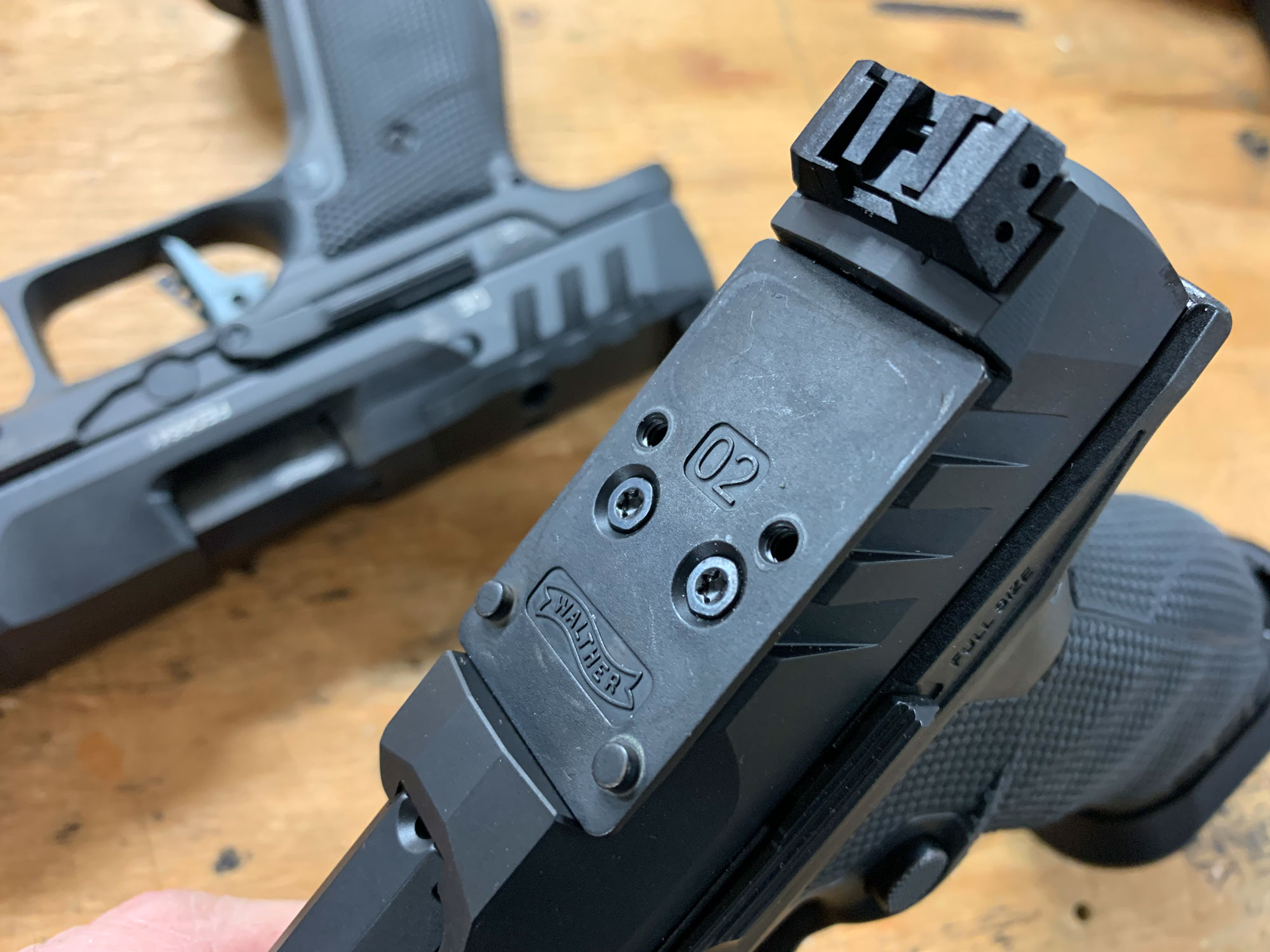
Walther PDP Steel Frame Match on the Range
For most of my time shooting the Walther PDP Steel Frame Match pistol, I focused on shooting drills and styles that would be applicable for competition and, as mentioned earlier, I shot it alongside other pistols like the Walther PDP Match (polymer frame), which is essentially the same pistol, but with a poly frame and it costs about $900 less. I also compared it to my Sig P320 AXG Pro, Glock G19, Glock G17, and Staccato P. The grip of the full-size PDP match pistols is chunky, and best-suited for shooters with large hands. The trigger reach is a bit longer than most other pistols, but it was a good fit for me.
Compared to its polymer-framed twin, the PDP Steel Frame had softer recoil and noticeably smoother cycling. It did very well on target transitions and staying on target while shooting, but couldn’t quite keep up with the speed of the 2011s. That’s splitting hairs though. Compared to all the striker-fired pistols I shot alongside it, the PDP Steel Frame Match was undeniably the most controllable and easiest to shoot accurately.
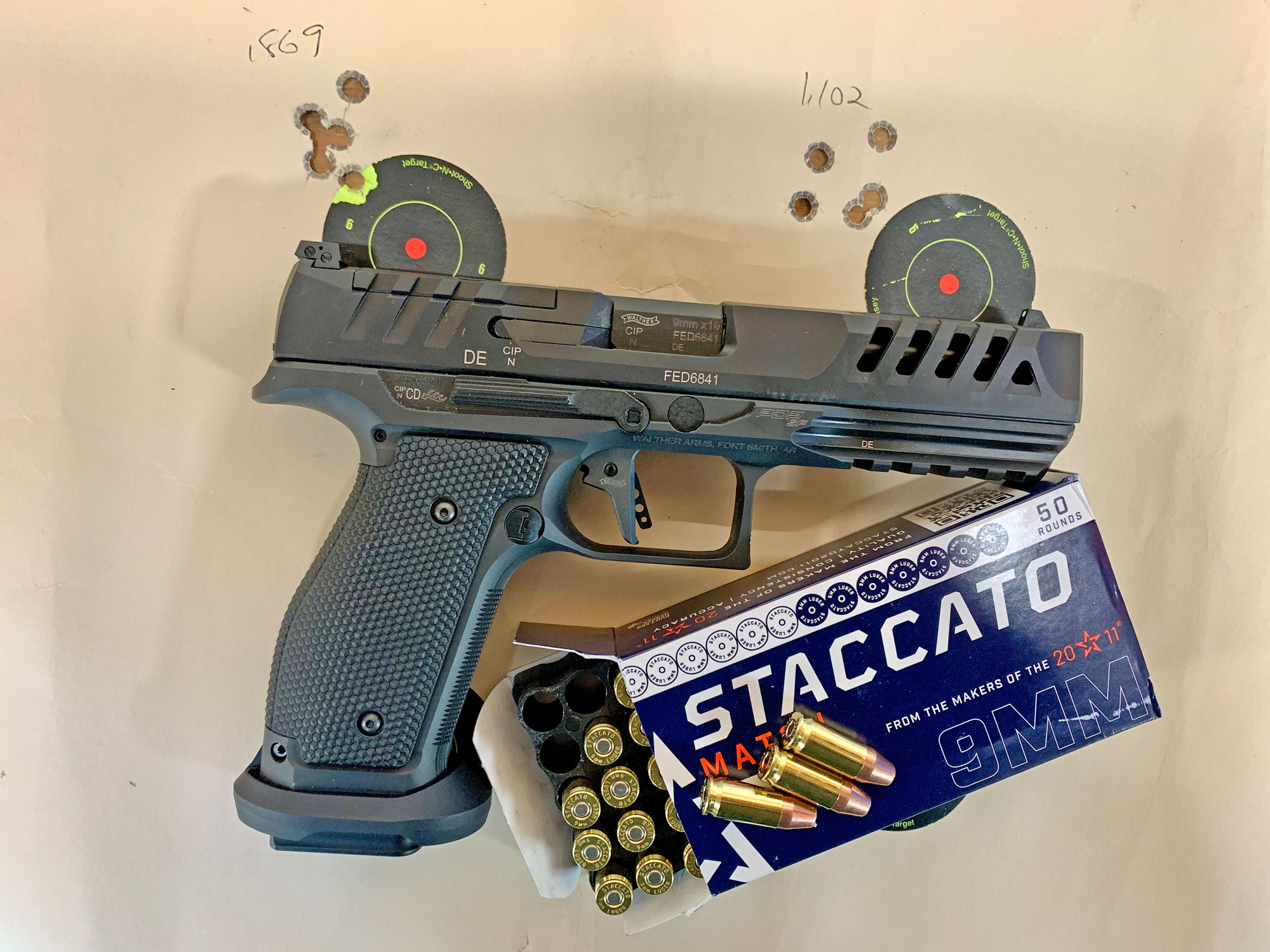
Accuracy
For specific accuracy testing, I shot 5-round groups through the Walther PDP Steel Frame Match pistol at 15 yards, from a braced standing position using a bagged tripod. With some of the more accurate ammo, I also shot a couple of groups at 25 yards. Most 9mm pistols that I’ve tested with this protocol average around 1.5- to 1.7-inch groups, and the PDP Steel Frame averaged 1.16-inch groups (19 groups). I tested for accuracy with 5 types of ammo ranging from Norma 65-grain NXD defensive loads to Federal Gold Medal 147-grain action pistol loads. The most accurate ammunition I tested was Staccato Match ammo, which averaged 1.01-inch groups (4 groups) at 15 yards and 1.27-inch groups (2 groups) at 25 yards.
What the Walther PDP Steel Frame Match Does Well
The steel provides an excellent grip and lots of recoil-mitigating mass. The pistol has excellent ergonomics and easy-to-run controls. An excellent trigger and good optic-mounting system make this a fantastic out-of-the-box competition pistol. There are few — if any — production striker-fired pistols that match it.
Where the Walther PDP Steel Frame Match Could Be Better
I think that some shooters with smaller hands will find the grip of the Walther PDP Steel Frame Match pistol too beefy and the trigger reach too long. I’d like to see the gun come with 3 20-plus-round magazines rather than 18-rounders. I think that the price is fair, but it is high. The $900 disparity between the steel- and polymer-framed pistols is a big difference for a single upgrade.
Final Thoughts on the Walther PDP Steel Frame Match
We continue to see guns of every type getting better, more accurate, and more shooter-friendly. The Walther PDP Steel Frame Match is a shining example of this. It’s a superb ready-made match pistol that’s reliable and tough enough for duty use too. The steel frame adds weight that tangibly helps the shooter fight recoil and, coupled with a great trigger, allows them to shoot faster and more accurately. I tried several striker-fired pistols against the PDP Steel Frame, and I simply couldn’t maintain the same pace and accuracy with them. Yes, it’s an expensive pistol, but there’s a big difference in what you get and how well you’ll be able to shoot it.
Read the full article here




